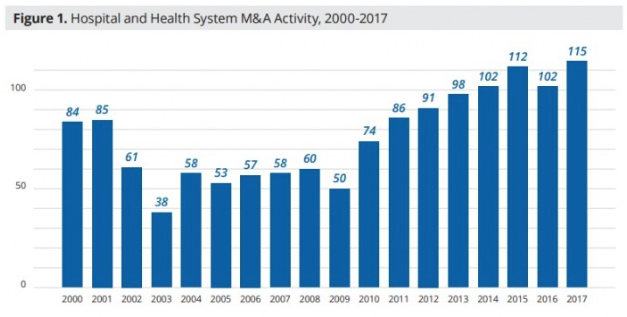Mergers and acquisitions are on the rise all across the healthcare industry. In 2017 alone there were 115 mergers, a record number. Since 2014, the number totals in the hundreds. What’s been driving this uptick? A lot of it has to do with providing value-based care while maintaining efficiency, cost control, and sustainability. Many argue that mergers and acquisitions are the only way for health care institutions to survive in a rapidly changing industry. But, how does this impact patients?

Source: Kaufman Hall
Costs
One of the main arguments surrounding mergers is that they can lower costs through structural changes. Organizations that combine often benefit from an increase in access to capital and resources. In the end, this has the potential to improve patient costs. A report from the American Hospital Association revealed a significant amount of savings: “Between 2009 and 2014, healthcare mergers and acquisitions led to a cost reduction of 2.5 percent, or nearly $5.8 million.” However, consolidation can also lead to fewer organizations in the market, reducing the amount of competition and limiting consumer options.
Mergers also benefit healthcare organizations by increasing their bargaining power with insurance companies. Healthcare organizations that take up the majority of the market have the power to negotiate with insurance companies. An organization may ask insurers to pay more for procedures and medical care, using its market share as a bargaining chip. This cost increase for insurance companies is often passed down to the consumer in the form of higher premiums. Large healthcare systems also have the opportunity to raise out-of-pocket prices due to a lack of competition, causing patients to increasingly risk financial hardship in order to access care.
Quality of Care
Mergers can save some patients from losing access healthcare entirely. This specific case happens when a large organization purchases a smaller one that could no longer operate by itself. The cost of supporting a less profitable small company can then be distributed throughout the organization, and the organization may be able to bring resources to bear on the original problem. Ultimately this is beneficial to the patient. Losing access to care in the scenario described can be detrimental to communities, causing patients to travel longer distances for the care they need, or forgo seeking care at all. Not only can mergers sustain accessibility, quality of care can increase. According to Patient Engagement HIT “When two entities merge, they more than likely streamline certain protocols, which can lead to enhancements and standards of quality care.”
Hospital mergers and acquisitions sometimes benefit the patient by increasing quality of care and sustaining accessibility. However these mergers sometimes come with a risk of increased out of pocket costs or premiums, often as an indirect effect of the merger. As these types of deals become more prevalent, organizations should consider the way to optimize the benefits for both the organization and the patient, and minimize the possibility for collateral damage.
To read the full report conducted by the American Hospital Association visit their website.

